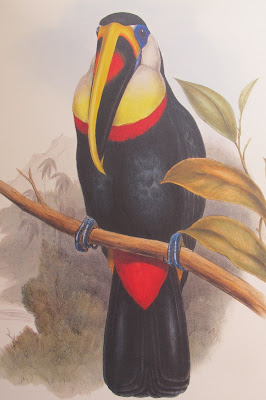John Gould (1804 – 1881)
The Bird Man
John Gould was the world’s most remarkable
designer, publisher and marketer of fine illustrated books on birds in the days
when a single individual could encompass all these demanding tasks. The plates
he designed have a subtle beauty of their own. In addition to being a highly successful business man, he
became one of the most renowned ornithologists of his day.
Gould was born in a small fishing village in the county of
Dorset, south-west England. Soon after this, the family moved to Stoke Hill,
near Guilford, Surrey. Here, the young Gould gained an appreciation for the
beautiful countryside and its abundant wildlife and he collected specimens.
Later he became a taxidermist, with clients including king, George IV. By 1827
he had won a competition held by the newly founded Zoological Society of London
and was duly appointed their official ‘Curator and Preserver’. In 1859, Gould
and his young wife whom he wed in 1829 moved to 26 Charlotte Street (now 23 Bloomsbury
Street), very near the British Museum.
When he saw the superb plates by the brilliant Edward Lear
for his adventurous but never to be completed Illustrations of the family Psittacidde, or parrots of 1830-1832,
John Gould was so impressed that he was inspired to produce a large format book
of his own. Lear was one of the first artists to use the recently developed
technique of lithography. In this, the artist is able to draw directly with
greasy chalk or ink onto thick slabs of smooth limestone, which could then go
straight to the printer, obviating the need for employing a skilled specialist
to engrave the drawing.
Gould’s first work, A
Century of Birds hitherto unfigured from the Himalaya Mountains of 1830 –
1833, contained plates of 100 bird species. These were made from drawings by
his wife Elizabeth, fresh both to marriage and the technique of lithographic
drawing. The venture proved so successful, they set about planning more works.
Gould’s achievement was astounding: in the 50 years between
1830 and 1880 he was responsible for a total of 18 imperial folio works, in 49
huge volumes, not to mention more than 300 smaller works, scientific papers,
notes and memoirs.
GOULD: Ramphastos Inca.
Inca Toucan
GOULD: Ramphastos toco.
Toco Toucan
Toucans in Art
That Gould should choose this group of birds as the subject of his monograph is not surprising, since these are fascinating, exotic creatures guaranteed to arouse curiosity and interest. Furthermore, despite their odd and rather ungainly appearance, they are stunningly beautiful, with the complex bold, multi-coloured patterns of their plumage and spectacular bills. Of course, being so striking and distinctive, toucans have played part in the myths and art of Native American people, often being associated with the sun. In Mexico, the Aztecs believed that the bill of the species now aptly known as the Rainbow-billed Toucan was actually created from rainbows, as a reward to the bird from the gods for acting as messengers. The bird figured in rain-making rituals, during which those beseeching the gods to send rain wore headdresses made of toucan feathers. The Maya of Central America and the Inca of Peru also revered toucans and depicted them in many works of art, ranging from ceramics to carvings.
GOULD: Ramphastos culminatus
Culminated Toucan
GOULD: Ramphastos erythrorhynchus
Red-billed Toucan
GOULD: Ramphastos vitellinus
Sulphur and White-breated Toucan
BTW - Tropical toucan prints led
the way at the London Fashion Week Issa London SS13 collection. Spruce up any interior with these beautiful prints!





No comments:
Post a Comment